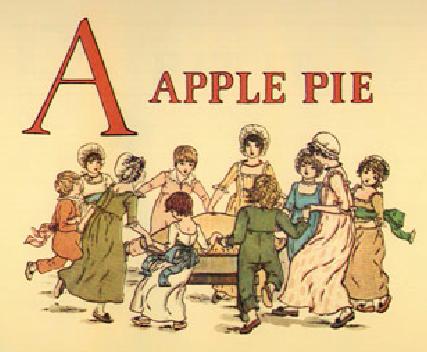
Illustrators: Kate Greenway Clothing Illustrations

Figure 1.--Many of Kate Greenway's characteristic early 19th century clothing styles are seen here including bonnets, long dresses, and longpants skeleton suits. She did not draw boys in either short pants or kneepants. Nor did she draw mid- and late-19th century styles like sailor and Fauntleroy suits. Notice the boy in a pink skeleton suit.
|
The children pictured in Greenway's theoretically set in the early 19th century, perhaps the 1810s-30s. They are not contemporary drawings or even Greenway looking back at her childhood. Greenway never updated the clothing style over the years. She never for example drew boys in Fauntleroy suits. I have also not noted sailor suits. They were an idealized notalgic look at an earlier simplier period--one reason that the drawings were so popular with the Victorians. Some of the common garments pictured in the drawings are bonnets, straw hats, dresses, smocks, pinafores, tunics, and long pants skeleton suits, and strap shoes. A HBC reader wonders about the children she drew in dresses. He asks, "Kate Greenway did a lot of drawings featuring children in quaint costumes. I think some of the children in dresses are boys. The only thing I have to base this on is the hats, very elaborate for the girls and plain for the boys with a single ribbon band. Given artistic license, how accurate do you think her depictions are?" The gender of the children wearing smocks and pinafores presents the same question. HBC does not know. Given that boys were not usually breeched until 4-6 years throughout the 19th century, it seems likely that she would have drawn the younger boys in dresses and smocks. HBC can not, however, confirm this.
Period
The children pictured in Greenway's theoretically set in the early 19th century, perhaps the 1810s-30s. They are not contemporary drawings or even Greenway looking back at her childhood. The dominance of long Empire dresses in Greenway's drawings date them clearly to the early 19th century as do the boys' skeleton suits and long pants.
Static Period
Greenway never updated the clothing style over the years. She never for example drew boys in Fauntleroy suits. I have also not noted sailor suits. We have just begun tomassess Greenway's drawings, but we see no evidence that they changed over time.
Idealized
Greenways's drawings were an idealized nostalgic look at an earlier simplier period--one reason that the drawings were so popular with the Victorians. The children are usually seen frolicking in the country side and small villages. They wear emaculately clean outfits of children from comfrtably--but not really rich families. Not pictured are children in the rags of the rising ranks of working-class children in the slums of England's expanding city. Kate Greenway in many ways provided the oposite of Charles Dickens's view of early Victorian children. Oliver Twist, at least until he was adopted, and the artfull Dodger would have looked very out of place in Kate Greenway's drawings.
Some of the common garments pictured in the drawings are bonnets, straw hats, dresses, smocks, pinafores, tunics, and long pants skeleton suits, and strap shoes. Many children wear head gear, mostly bonnets and straw hats. The girls might have garlands of flowers. The girls always wears long dresses with brightly colored waist sashes. Some wear pinafores over their dresses. Some children wear smocks. Older boys wear longpants skeleton suits and tunics. The boys' skeleton suits are quite similar, although trim like ruffled collars varied. They of course always had long pants. Some of the boys' skeleton uits also have sashes. There is a remarkable similarity in these garments throughouts Greenway's many publications. Often they seem little different except for the trim.
The gender of most of the children in Kate Greenway's drawings are obvious. The children in long pants skeketon suits are always boys. The older children in dresses are girls. The children in bonnets are almost certainly girls. The younger children in dresses and smocks, however, are less clear. A HBC reader wonders about the children she drew in dresses. He asks, "Kate Greenway did a lot of drawings featuring children in quaint costumes. I think some of the children in dresses are boys. The only thing I have to base this on is the hats, very elaborate for the girls and plain for the boys with a single ribbon band. Given artistic license, how accurate do you think her depictions are?" The gender of the children wearing smocks and pinafores presents the same question. HBC does not know. We do not know to what extent Greenway herself considered this issue. Given that boys were not usually breeched until 4-6 years throughout the 19th century, it seems likely that she would have drawn the younger boys in dresses and smocks. HBC can not, however, confirm this. One important factor to consider is that if some of the younger children in dresses are not boys, girls are then heavily over populated in Greenway's drawings.
Color
HBC can note no color conventions in Kate Greenway's drawings. Notice for example that one of the boys in the "A" image above wear a boy wears a pink skeleton suit. We do not know how relecive of reality such depictions were. It is clear, hoever, that for Kate Greenway pink was not a color exclusively for girls.
Christopher Wagner

Navigate the Boys' Historical Clothing Artist pages:
[Return to the Main Kate Greenway page]
[Return to the Main illustrator page]
[Return to the Main artist page]
[Chronology]
[Countries]
[Individuals]
[Styles]
Navigate the Boys' Historical Clothing Chronological pages:
[Return to the Main 19th chronolical page]
[The 1800s]
[The 1810s]
[The 1820s]
[The 1830s]
Navigate the Boys' Historical Clothing Web Site:
[Introduction]
[Activities]
[Bibliographies]
[Biographies]
[Chronology]
[Clothing styles]
[Countries]
[Literary]
[Contributions]
[FAQs]
[Glossaries]
[Satellite sites]
[Boys' Clothing Home]
Created: December 2, 2001
Last updated: December 2, 2001



